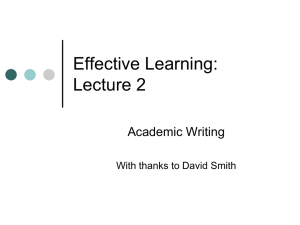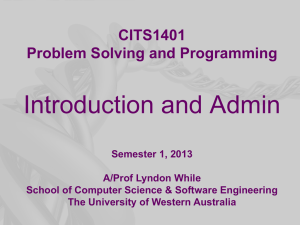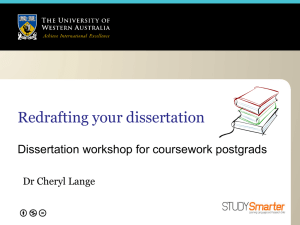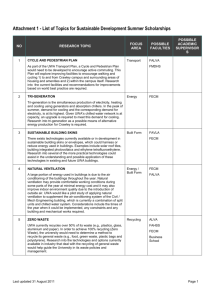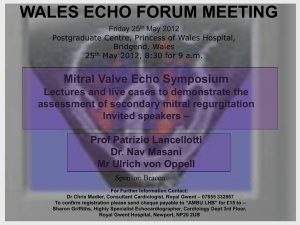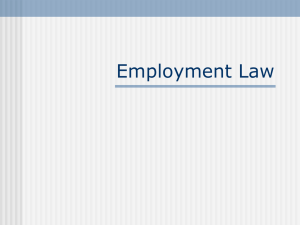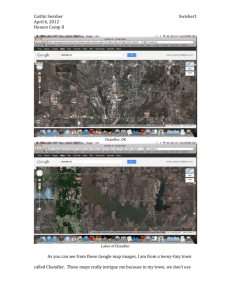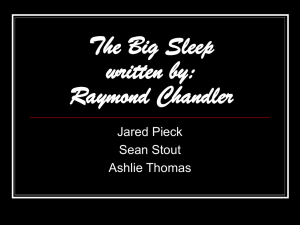Effective Learning: Lecture 2
advertisement
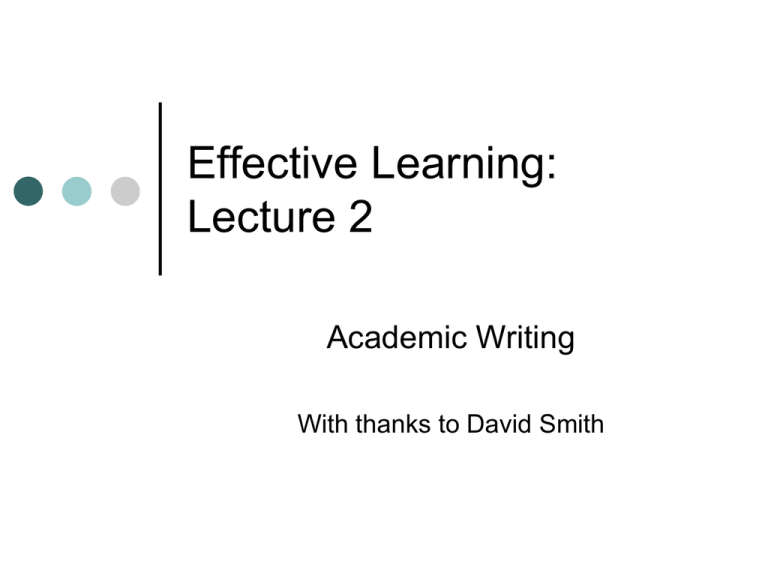
Effective Learning: Lecture 2 Academic Writing With thanks to David Smith Approaching Academic Writing Who are you writing for? What How are you trying to say? are you going to say it effectively? Differences Between Academic and Personal Writing Personal Writing Academic Writing Tells a story Comments, evaluates, analyses Non-technical vocabulary Subject-specific vocabulary ‘I’ at the centre ‘I’ as observer and commentator Information comes from the writers experience Information comes from sources and refers to what others say Personal views and feelings Evidence and arguments Conventions for citation Crème P & Lea M, Writing at University, Buckingham, OUP, 1997, p. 105 Approaches to Writing: 1 The Architect Strategy: ‘I think and plan before I even begin to think about starting to write.’ Adapted from Chandler D, The Act of Writing: A Media Theory Approach, (Aberystwyth; University of Wales Press, 1997), pp. 229-36, by Julian Brasington, LLC, UWA Approaches to Writing: 2 The Bricklaying Strategy: ‘ I write so slowly that I am rewriting as I go along… I try never to leave a sentence until it’s as perfect as I can make it…’ Adapted from Chandler D, The Act of Writing: A Media Theory Approach, (Aberystwyth; University of Wales Press, 1997), pp. 229-36, by Julian Brasington, LLC, UWA Approaches to Writing: 3 The Oil Painting Strategy Kurt Vonnegut: ‘I play with these ideas until they start to feel right. It’s something like oil painting. You lay on paint and lay on paint. Suddenly you have something and you frame it…’ Adapted from Chandler D, The Act of Writing: A Media Theory Approach, (Aberystwyth; University of Wales Press, 1997), pp. 229-36, by Julian Brasington, LLC, UWA Approaches to Writing: 4 The Water-colour Strategy ‘Before I write, I write in my mind. The more difficult and complex the writing, the more time I need to think before I write. Ideas incubate in my mind… The writing process takes place in my mind. Once that process is complete the product emerges.’ Adapted from Chandler D, The Act of Writing: A Media Theory Approach, (Aberystwyth; University of Wales Press, 1997), pp. 229-36, by Julian Brasington, LLC, UWA The Process of Writing Analyse question Check current knowledge e.g. lecture notes Brainstorm Collect material Organise Plan Write Re-write/ edit Analysing the Essay Question Read the question carefully, checking any unknown vocabulary Suggestion: use coloured pens or highlighters Draw a box around phrases which instruct you how to tackle the questions Outline / evaluate / analyse / justify / describe Identify and underline the words or phrases which establish what the subject/s of the question is / are Underline with dashes, the refining words/ phrases which further limit the subject area Analysing the Essay Question- Example Outline and critically discuss modern methods of flood protection with particular reference to non-structural and environmentally-friendly solutions. Instruction words Subject/topic words Refining/focus words The Role of the Introduction Give the background to the main topic of the essay; the history or the context. Present the central idea of the assignment. Justify why the question will be answered in a particular way. The Role of the Conclusion Refer back to the question posed in the title and show that it has been answered Point out what the assignment has and has not answered. Put forward the your view in light of the evidence that has been presented. Do not introduce new information in the conclusion Give a sense of an ‘ending’. Adapted from Crème & Lea, p. 121 Why Reference? To avoid plagiarism and bad practice http://www.aber.ac.uk/en/student/ug-issues/examassess/handbook/section-13/ To show there is evidence for your ideas To show you have read within your subject area To inform your reader of the nature and range of your source material To show you are able to select and use appropriate material To provide accepted conventional acknowledgement that parts of your work have been derived from other people Follow departmental referencing guidelines and be consistent Adapted from: Trzeciak J & Mackay S, Study skills for Academic Writing (London: Prentice Hall, 1994), p. 56 Questions to Ask When Checking Your Work: 1 Does the introduction act as a signpost for the whole text? Does the assignment address the question? Does the text have a central idea? Is the idea apparent to the reader or does the reader have to search for it? Do any points need more explicit ‘framing’ to provide a necessary context? Does the text raise questions that it does not answer? Is there a sense of an argument developing? Questions to Ask When Checking Your Work: 2 Is the evidence provided substantial? Are the illustrations/examples relevant? Do points follow logically? Does the whole piece hang together coherently? Why is this piece of information in the text? What purpose does it fulfil? Is the use of subject specific terminology clear? Is the ending satisfactory? Worthington, P. Language & Learning Centre, UWA 2003 Presentation Follow departmental guidelines, e.g. Text spacing Font size Page numbers Cover page requirements Bibliography Always save a copy on your own computer and store on your university M drive Feedback Don’t just ignore it Take on board both positive and negative comments If you need more, then ask your tutor The End Any questions? Study Practices Programme (Student Support): • Classes for writing, seminar/lecture skills, information skills • Individual consultations with RLF Writing fellows http://www.aber.ac.uk/en/studentsupport/study-skills/
